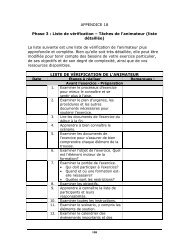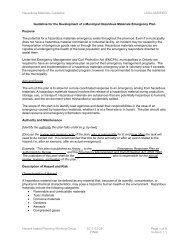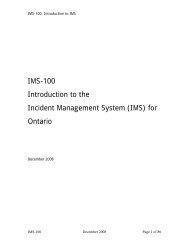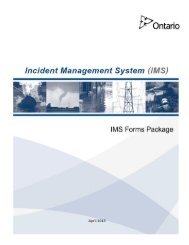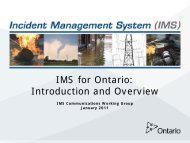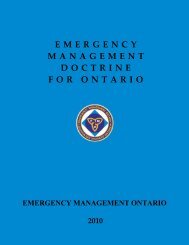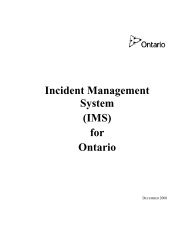Energy
PDF Version - Emergency Management Ontario
PDF Version - Emergency Management Ontario
- No tags were found...
You also want an ePaper? Increase the reach of your titles
YUMPU automatically turns print PDFs into web optimized ePapers that Google loves.
Ontario Government Emergency Fuel Distribution Protocol<br />
Appendix B - Best Practices for Critical<br />
Infrastructure Owners and Operators<br />
& Communities<br />
As part of the emergency planning process, communities<br />
and CIs should consider measures that can be<br />
taken in advance to mitigate the potential effects of a<br />
fuel shortage.<br />
All communities and CIs should have a robust emergency<br />
preparedness and response plan to deal with<br />
threats.<br />
Strategically located sources of auxiliary electrical<br />
power generators with adequate capacity and on-site<br />
fuel reserves can increase the robustness of continuity<br />
of operations.<br />
Ideally, communities and CIs should prepare to be<br />
self sufficient for three days as prescribed by EMO<br />
guidelines.<br />
The development of a robust business continuity plan<br />
(BCP) will enhance the operational resilience of organizations.<br />
Business Continuity Plans<br />
advance of and during a fuel supply disruption.<br />
Ensure clear and concise pre-approved messages<br />
are ready, as well as a means of communicating<br />
them to key stakeholders.<br />
Maintain emergency contact list of critical staff and<br />
stakeholders.<br />
Maintain an emergency operations centre and alternate<br />
site.<br />
Keeping a supply of critical parts / commodities to<br />
ensure continuity of service.<br />
Mutual aid, sharing resources and or expertise<br />
with other organizations.<br />
Keep details of alternative suppliers should primary<br />
supplier fail.<br />
Car sharing or alternative modes of transport for<br />
essential staff.<br />
Lodging facilities for critical staff.<br />
Information technology plan / strategy.<br />
Interdependencies with other CIs / organizations.<br />
Incident management system.<br />
Staff training and awareness.<br />
Weather or seasonal patterns that may affect<br />
BCP.<br />
Review and exercise BCP regularly.<br />
Recommendations regarding Stationary Emergency<br />
Power Generators<br />
BCP should consider and include the following:<br />
Emergency management coordinator to develop<br />
and maintain BCP.<br />
Hazard identification and risk assessment.<br />
Mitigation, preparedness, response and recovery<br />
measures / strategies.<br />
Identify all fuel supply vulnerabilities and prepare<br />
for them.<br />
Establish firm contract with fuel supplier and ensure<br />
supplier has a robust contingency plan. This<br />
could include backup power generators at retail<br />
sites and distribution terminals.<br />
Identify, prioritize and reallocate resources<br />
(including staff) to deliver only critical services and<br />
products.<br />
Reducing fuel usage and conserving where possible.<br />
Improving the resilience of service contracts and<br />
supply chain management (not just fuel but other<br />
supplies the organization needs to deliver its key<br />
services and products).<br />
Establish effective communication with staff, customers,<br />
suppliers and other key stakeholders in<br />
Generators should be properly maintained and<br />
tested under load on a regular basis. Ensure fuel<br />
quality and quantity level are maintained.<br />
CIs and communities should have a firm contract<br />
with a fuel supplier. They should ensure that their<br />
supplier understands that CIs and communities<br />
are a high priority in an emergency situation.<br />
They should also ensure their supplier has a robust<br />
contingency plan. The potential declaration<br />
of a Provincial emergency and the use of force<br />
majeure should be considered in contract discussions.<br />
CIs and communities should consider diversifying<br />
the fuel supplies for their life-safety emergency<br />
and backup generation fleet by including continuously<br />
piped natural gas from the gas utility whose<br />
service is independent of the electrical grid. Retrofitting<br />
existing diesel generators to operate on a<br />
combination of diesel and natural gas, commonly<br />
referred to as bi-fuel or dual-fuel, may be practical.<br />
Its main advantage is to extend the run-time of the<br />
stored diesel fuel inventory and thus increase<br />
7



